- Details
- Written by: Gianna Esquivel
- Hits: 1711
Mexican big, colorful, and noisy celebrations are popular worldwide. Frequently, some tourists plan they're staying in Mexico during a national celebration. Independence Day, Day of the Death, or Day of the Guadalupe Virgin are good examples of such celebrations. Religion, faith, Politics, national pride take the streets and offer a cultural ‘parade’ of local traditions, gastronomy, and music.

| Follow PackAndGo.info at: | |
| YouTube | @packandgo. |
| @packandgo.info | |
| X | @packandgoinfo |
| @packandgo.info | |
| Bluesky | @packandgo.bsky.social |
| TikTok | @packandgo.info |
Everything is fine, but watch out! If you plan to visit Mexico during May because you have heard about Cinco de Mayo's big celebration, read this article first and avoid being disappointed.
I’m Mexican and I live in Mexico City. More than once, I have been asked by tourists “Where is the Cinco de Mayo celebration?”, “At what time do you start partying?”. The answer is simple, we don’t celebrate Cinco de Mayo with a big party. We remember the victory of a battle that took place around Puebla. It’s a national holiday. Many people, especially office workers, have a free day and that’s it.
The answer has visibly disappointed some tourists. Once, one of them commented to her friends “let’s ask someone else. She doesn’t know”. This is how solid the belief of many foreigners about this celebration is. Obviously, there’s confusion here, and being more exactly, it's confusion arisen in the US.
What is Cinco de Mayo in English?
Cinco de Mayo is a date expressed in Spanish. It’s May the 5th in English. And it refers to The Battle of Puebla Day, an event in Mexican History that occurred on May 5th, 1862. Mexicans won a battle against the French in the surroundings of the Mexican state of Puebla.
What does Cinco de Mayo represent for Mexicans?
Cinco de Mayo represents pride and identity for Mexicans. It’s part of the country’s history.

Is Cinco de Mayo celebrated in Mexico?
To be accurate, Cinco de Mayo is commemorated every year in Mexico by the federal and local governments and citizens, mainly through official acts. A military parade, official speeches and some recreations of the battle take place, mainly in the Mexican State of Puebla. But Mexicans don’t celebrate with the spectacular national party that many people think.
It’s a holiday (rest day) in the Mexican calendar, especially for office employees.

Is Cinco de Mayo the Mexican Independence Day?
No, Cinco de Mayo is not Mexican Independence Day. Cinco de Mayo or May 5th is Battle of Puebla Day in Mexico.
Mexico’s Independence Day is celebrated on September 16th. On this date in 1810, the war to fight for Mexican Independence started. It lasted ten years. And the Mexican Independence was officially recognized by Spain until 1836. This is one of the biggest celebrations in Mexico and festivities start the previous night (September 15th).
Is Cinco de Mayo a Mexican celebration?
Not really. Cinco de Mayo is a Mexican historical commemoration. But Cinco de Mayo's big celebration (party) is mostly a US creation. A date promoted by American beer companies, restaurants, bars, etc. to have a drink day yearly. And the festivity involves not only Mexicans but all Latinos living in the US.
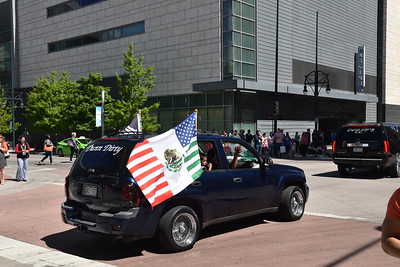
What is Cinco de Mayo about? - Origin of this commemoration.
Time for a bit of Mexican History to explain Cinco de Mayo's origin!
Let’s go back to the 19th century, exactly to the 1860s decade. It was really a hard time for Mexico. The loss of half of the territory was recent and the War of Reform was too. As a result of this last war, the country got divided and confronted, conservatives and liberals, and Benito Juárez became president.
Juárez got a big challenge. The conflicts practically destroyed and plunged into poverty the country. Around 70% of the economic resources were used to pay external debts with France, England, and Spain. The country needed to be rebuilt urgently and resources were needed. Therefore, Benito Juárez suspended these payments. The decision was not well taken by the European countries that mobilized their troops to invade Mexico. Juárez reached an agreement with England and Spain, so they withdrew their troops. But France invaded Mexico.

On May 5th, 1862, when the French troops were heading to the capital (6,000 men), a battle took place in the surroundings of Puebla. Mexico defeated the French.
Historians explain that the French lost the battle because they underestimated the Mexican army from the very beginning. And yes, they were inferior in force (artillery, ammunition, etc.) and experience but they got prepared and improvised as they could. There were many volunteers in the Mexican troops. Yes, people without military training decided to defend their nation.
Mexicans won a battle and stopped France's invasion just for a while. One year later, France got back with 35,000 men to invade Mexico. The conflict finished until 1867 when Emperor Napoleon III withdrew France troops from Mexico. By that time, France was facing two threats, the Prussian in Europe and the American one that was pushing for them to leave Mexico.
Summing up, Cinco de Mayo de 1862 represents for Mexico the victory of a battle against the French troops. Although, that didn’t stop the French invasion.
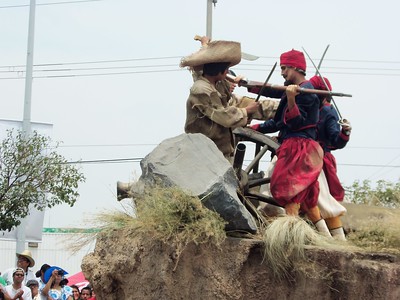
When was Cinco de Mayo first celebrated in the US?
Cinco de Mayo, the date of the Mexican victory of the Battle of Puebla, was first celebrated in the US by Mexicans, in 1862, after the battle occurred. Consider that then, just like now, there was a big amount of Mexicans living in the US. Especially in the South. Although the victory of this battle didn’t mean the end of the war against France, it deeply inspired the Mexicans to keep fighting.
In 1863 and the upcoming years, the historical victory was remembered and celebrated by the Mexicans that still were at war. French troops left Mexico until 1867. From 1862 to today, this chapter has been an iconic remembrance to encourage Mexicans not to give up.
How was Cinco de Mayo first celebrated in the US?
Cinco de Mayo, the Battle of Puebla Day, was first celebrated in the US by Mexicans. But the celebration didn’t involve frozen margaritas, tacos, or fireworks like today. It was more a patriotic commemoration for Mexicans. During the whole 1860s decade, this historical event was a remembrance to encourage Mexicans not to give up. The French invasion finished in 1867.
Why Cinco de Mayo is celebrated in the US?
Well, first of all, Cinco de Mayo was celebrated in the US because in the past, just like today, many Mexicans were living there. In 1862, when Mexico won the Battle of Puebla against France and the following years, the ones celebrating the patriotic achievement were Mexicans living in the American territory.
Americans joined the Mexican celebration as a way to express their solidarity against France. Don’t forget that in the US, the American Civil War was on (1861-1865).
A century later, Chicanos (Americans of Mexican origin or descent) recovered the holiday as an ethnic pride symbol.
But with time, the history behind this Mexican commemoration in the rest of the American population started getting blurry or lost. It was until the 1980s, that American beer companies promoted this date to have a big celebration. It was a Marketing campaign to reach the big and growing Spanish-speaking population in the US.
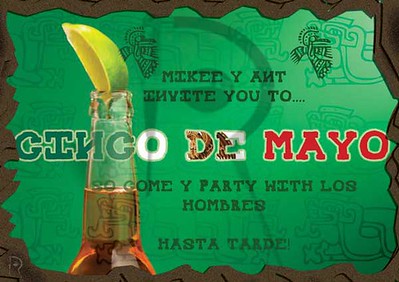
Part of the campaign succeeded. Exactly the idea of a big party full of Mexican food, beers, music, fireworks, dance, and parades directly stuck on people’s minds. But not the historical event. The reason for such a celebration was forgotten and twisted year after year. Therefore, a misconception among Americans about Cinco de Mayo as Mexican Independence Day got born.
As you see, Cinco de Mayo big party was created by American Marketing. And based on the vast presence of Mexicans in the US, in states like California, Texas, and Los Angeles, currently this date is used with a different meaning, to celebrate the Mexican-American culture.
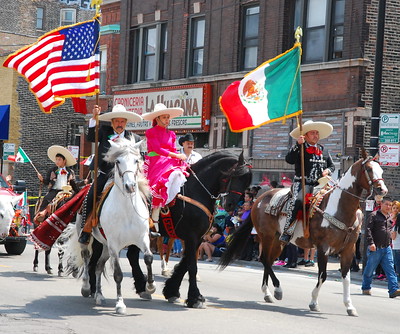
How Cinco de Mayo is celebrated in the US?
Cinco de Mayo is celebrated in the US with festivals, parades, Mexican music, traditional dancing, and of course, Mexican food and drinks.
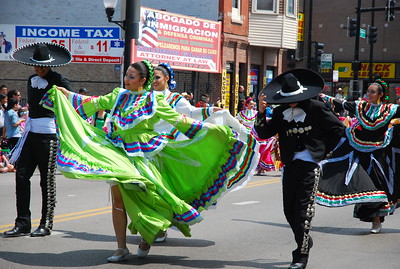
What’s the traditional Cinco de Mayo food?
In Mexico, there’s not a specific Cinco de Mayo menu. But in the US celebration, there is. Restaurants Cinco de Mayo food usually include tacos, guacamole, nachos, tequila, frozen margaritas, and beer.
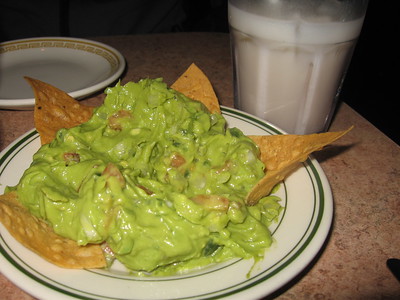
If you are in Mexico on this date, you can try a lot of different Mexican food that is available all year. In Puebla, you can try mole or chile en nogada.
Should I go to a Mexican restaurant in Cinco de Mayo?
Mexican food and drinks are popular worldwide. And every day of the year is good to visit a Mexican restaurant for enjoying them! Just, if you are in Mexico, don’t expect something specific or a party environment on this date.
In the US, if you go exactly on May 5th, restaurants will have a specific Mexican style food on the menu, drinks, maybe a mariachi but mostly a party environment.
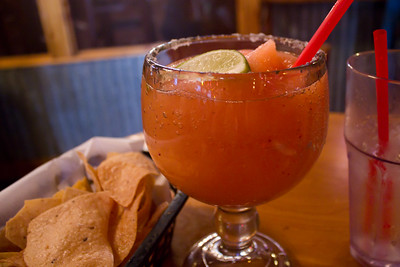
Conclusion.
To visit Mexico and enjoy its food and vast geography is always worth it! You will eat deliciously, drink, and have fun no matter the month of the year. If you go on May 5th, you won’t find a massive celebration but be sure you will enjoy your visit. Here you can find some cool recommendations, so you can just pack and go!
And if you want to experience the American Cinco de Mayo, add US to your trip list. And share your experience with us!
| Follow PackAndGo.info at: | |
| YouTube | @packandgo. |
| @packandgo.info | |
| X | @packandgoinfo |
| @packandgo.info | |
| Bluesky | @packandgo.bsky.social |
| TikTok | @packandgo.info |
- Details
- Written by: Gianna Esquivel
- Hits: 2413
Guys, we have received different questions related to the Mexican sombrero. It’s great you liked our article “The Mexican sombrero is an experience everybody should try!”. And it’s very nice too, that you got interested in having a Mexican sombrero! So, here you have a useful guide to choose and buy one!
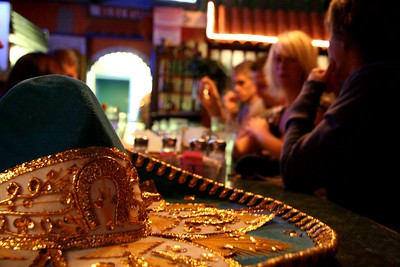
We are PackandGo.info ! Share your travel experiences with us!
| Follow PackAndGo.info at: | |
| YouTube | @packandgo. |
| @packandgo.info | |
| X | @packandgoinfo |
| Bluesky | @packandgo.bsky.social |
| @packandgo.info | |
| TikTok | @packandgo.info |
How long does it take to make a Mexican sombrero?
The time to make a Mexican sombrero varies based on the level of detail and ornaments the client orders. The most valued embroidery is handmade and it can take days to finish complex designs. But in general, consider from a couple of days to a complete week as a reference.

How much does a Mexican sombrero cost?
Let’s make a distinction first. A true charro hat is the work of specialized artisans. It’s very different from what commonly you can get in tourist souvenir shops. If you look for a souvenir, a Mexican sombrero or charro hat can cost from 20 USD to 40 USD. While an artisan’s version can start at 250 USD.
Materials (wool, palm, leather, wheat straw, rabbit hair or suede), ornaments (amount and complexity), and time to make it will define the final cost.

Where to buy a Mexican sombrero?
Well, you can buy a Mexican sombrero in a souvenir shop. There are many all around Mexico. But also you can get one at one of the also many specialized workshops that exist. Jalisco, Hidalgo and Michoacán workshops have good reputation. But for sure, you can find one in every state of Mexico.
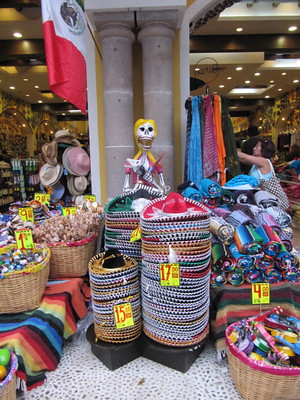
How to know your size to buy a Mexican charro hat?
Well, you can try on the hat in the store. But especially if you want a custom-made sombrero, it’s better to measure your head and height.
Get a measuring tape and place it around the head, above the ears, at the middle of the forehead, and in the most prominent part of the back of your head. This is the level where the hat normally sits. Tighten the tape measure, but not too much. The idea is to tighten the tape to get the ideal size where the hat will hold up and not slip. Be sure you know your height. This datum is important to balance the hat brim dimension. If you are too tall, the brim will go wider than if you are short. Otherwise, the result could be cartoonish.
If you don’t have a measuring tape or you get confused between centimeters and inches avoid mistakes. Here you have a simple tip. Take a ribbon and adjusted it to your head following the previous instructions. Make a knot or a mark on the ribbon. Then take it to the sombrero shop or artisan of your preference and with this reference, they could get your head’s measure and even your height. If you are a regular user of hats, pick the most comfortable one you have and give it to the artisan as a reference. You also can do this in case you want to buy the sombrero as a gift for someone else.
Remember, the wrong hat size can result in the hat being too tight and uncomfortable, or too loose. A hat constantly falling off your head or tilting unfavorably won’t be nice.
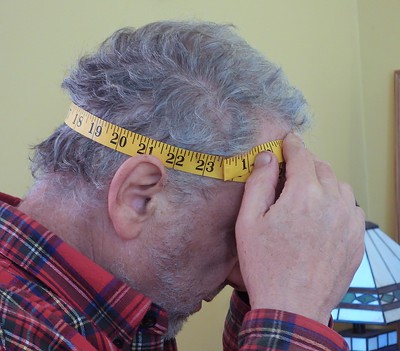
Can I buy online a Mexican sombrero?
Sure! You can buy a Mexican sombrero online. There are many e-shops that offer this product. Just consider the sombrero could be made in whatever other country, not necessarily in Mexico. Another aspect to consider is that e-shops sell a lot of these sombreros as a costume. Quality and price will clearly differ, between an artisan sombrero and a costume version. If you want one just to have fun and you are not in Mexico, it could be a choice.
In any case, you will need to measure your head. E-shops usually publish a size table for clients to check and order the proper size.
Besides this, follow the regular steps to shop online. Check policies, terms, and conditions of the shop, its legitimacy, customers reviews, not to be scammed.
Why is the sombrero so important to Mexico?
Sombrero is important to Mexico because it has become a cultural icon, a national expression of pride, identity, and celebration for Mexicans. It represents for the whole country tradition and roots.

Do Mexicans still wear sombrero?
Yes, Mexicans still wear the traditional sombrero but not on a daily basis. The primary use of sombreros (weather protection) is still important for people who work in the countryside, especially with livestock. “Charrería” exhibitions and national celebrations are also occasions to wear the Mexican sombrero. But being as highly populated as Mexico is, it’s hard to imagine space enough for all Mexicans to wear one simultaneously.
To walk in a crowded street or to access the metro wearing sombrero, especially during peak hours, could be absolutely challenging!
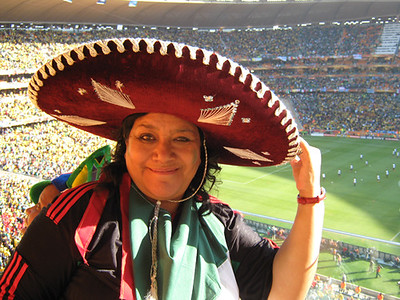
Do you recommend wearing a Mexican sombrero?
Before trying a good Mexican sombrero, I thought vision and walking could be hard but actually is comfortable and designed not to be an obstacle for you. I’m not a regular hat user, so to wear this big sombrero was absolutely fun! Of course, I recommend wearing one at least to feel it and get a fun pic as a memory of your trip.
Now you know all the necessary information to get a sombrero. There is no excuse not to have a beautiful Mexican hat!
Guys, share with us your pics wearing a Mexican sombrero! It would be fun! PackandGo.info
| Follow PackAndGo.info at: | |
| YouTube | @packandgo. |
| @packandgo.info | |
| X | @packandgoinfo |
| Bluesky | @packandgo.bsky.social |
| @packandgo.info | |
| TikTok | @packandgo.info |
- Details
- Written by: Gianna Esquivel
- Hits: 3733
While traveling, one of the experiences we try not to miss is to listen to local music! It’s not about being an expert on the topic. It’s about letting local melodies get inside your head and move your body. As we have said before, music is an alternative way to travel too! Through it, you can know a bit more about the people of the country or city you visit.
In this sense, the mariachi is one of the most iconic elements of Mexican culture. The music itself, the suit of the singers, their popular “sombrero” (hat), and the instruments they play are internationally known.
If you are curious about mariachi or if you are planning to visit Mexico, here you have everything you need to know about Mexican mariachi!
| Follow PackAndGo.info at: | |
| YouTube | @packandgo. |
| @packandgo.info | |
| X | @packandgoinfo |
| Bluesky | @packandgo.bsky.social |
| @packandgo.info | |
| TikTok | @packandgo.info |
What’s mariachi?
Mariachi is a popular Mexican musical ensemble. In a mariachi, you can find stringed, wind instruments and vocals. Traditionally, these ensembles feature at least three musicians (guitar, guitarrón, and vihuela performers) dressed in “charro” suits. The mariachi is an important element of the Mexican tradition and identity. The word mariachi is also used to refer to every member of the musical ensemble. The performers are mariachis and the group they integrate is a mariachi.

Is mariachi a French word?
No, mariachi is not a French word. Mariachi is an indigenous Mexican word attributed to the already extinct Coca language. Coca people were an old indigenous group that settled in the region of the current Mexican states of Nayarit, Jalisco, and Colima. They lived in houses built with seashells. The ocean and the wind were their gods. They were also known because of their shaft tombs. One of the best-known Coca settlements was the one of Cocula, Jalisco in the 12th. century.
There’s a wrong version that stated, the word mariachi was the result of a misunderstanding or corruption of the French word “mariage” (wedding or marriage). These musicians used to be part of weddings’ entertainment. French people made the association between the occasion, “mariage”, and the presence of the musical group on it. And the gap created by the lack of a common language originated the confusion, so the musicians began to be called “mariache” or “mariachi”.
It’s been proved already that this version is a mistake. Historical documents show that the mariachi word and its use to refer to the Mexican musical ensemble existed so much before (at least from the 12th century) the French Intervention took place (the 1860s, 19th. century).
If you find similarity in the pronunciation of the French “mariage” and the Mexican mariachi, it’s just a phonetic coincidence.
Is mariachi Spanish or Mexican?
The mariachi is Mexican. However, its creation is the result of a mix of three influences: the indigenous Mexican, the African, and the European ones.
When the Spanish arrived in Mexico (1519), the Mexican indigenous had already developed their own musical instruments and traditions. European conquerors brought to the new continent their own music, just like the African slaves that travel with them. After a time, Mexican indigenous got interested in the foreign instruments and rhythms so they mastered them and incorporate them into their own music.
The mariachi was developed in a big Mexican region that included the current states of Sinaloa, Durango, Colima, Michoacán, Aguascalientes, Guanajuato, Zacatecas, Jalisco, Nayarit and Guerrero. Jalisco is frequently mentioned as the place of its origin. But historians don’t point out a single state as the mariachi birthplace, but a whole region.
If you want to know more interesting details about the origin of mariachi, check our article “Long live the amazing Mexican mariachi!”.
Is mariachi plural or singular?
Mariachi is singular. Mariachis, plural. Mariachi can refer to both, the musical ensemble and the musician that plays in it.
What instruments are used in a mariachi?
The instruments a mariachi uses to play, and the amount of them can vary between the different groups. This is defined mostly based on regional trends. Historically, the Mexican versions of the vihuela, the guitarrón, and “guitarra de golpe” have been pointed out as the backbone sound line of the mariachi.
But talking generally, the instruments that are used in a mariachi are the following.
- Mexican vihuela.
There’s a Spanish vihuela but don’t be confused, they are not the same instrument.
- Mexican guitarrón.
- Mexican “guitarra de golpe”.
With time, it has been replaced in many groups by the classical Spanish guitar.
- Violin.
- Trumpet.
- Vocals.
The vast repertoire of mariachi also includes instrumental music and versions.
- Harp.
To know more about mariachi’s instruments, you can read “Long live to the amazing Mexican mariachi!”.
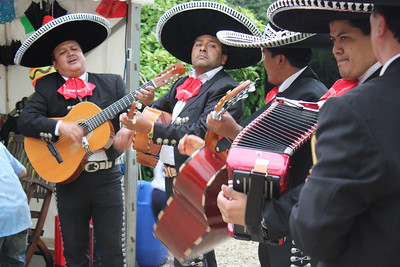
How many members does a mariachi have?
The minimum amount of members a mariachi has is three, to cover the base sound line (Mexican vihuela, guitarrón, and guitar). But there’s no limit up to integrating a mariachi. Currently, there are musical groups of six, eight, and even more than ten members.
Mariachi in Mexico has been constantly experimenting with the addition of instruments and more than one performer of the same instrument. To have more or fewer violins, more than one trumpet, flutes, accordion, etc. depends on the sound the ensemble wants to get. Some look for having a signature, something to be distinguished from other groups, emphasizing the presence of a certain instrument over others.
This totally defines the number of members mariachis have.
Who is the singer in a mariachi?
Mariachis usually don’t have a lead singer. Every member in the ensemble sings. Sometimes they sing all together during the complete song. Some songs demand a lead singer and the other mariachis only sing the chorus. The use of the voices is defined by the needs of the songs and by the musical creativity.
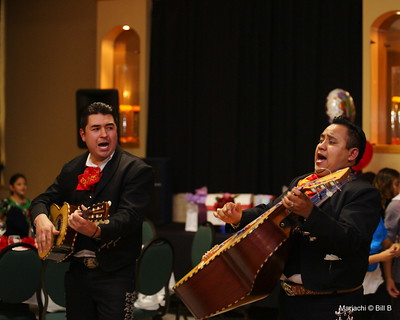
Can women be mariachis?
Of course, women can be mariachis. Historical documents show that already in 1903, there was a woman playing in a mariachi. Her name was Rosa Quirino. It doesn’t mean she was the only one, but maybe she is the only one who was documented at that time. Later, in 1948, an all-female mariachi ensemble was created in Mexico City, “Las Adelitas”. Its director seemed to get this idea after he saw a tropical orchestra integrated completely by women in Cuba.
What historians explain is that the context in which mariachi groups used to play were mostly rural areas and celebrations where alcohol was a constant. Some musicians were traveling from town to town for work. And such an environment, especially in the 19th century was considered not appropriate for women. That’s why mariachi grew up until a certain historical point, more like a musical tradition for men.
Currently, it’s not hard to find all-female mariachis with great musical quality!
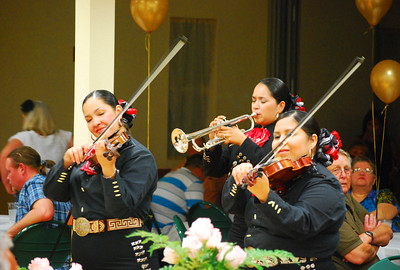
What do mariachis wear?
Currenty, mariachis wear “charro” suit. The tightly-fitting and ornamented pants, the embroidered belt, the short jacket, vest, wide bow tie, boots, and the popular wide brim “sombrero” (hat). For women, instead of the pants, they wear a full-length skirt.
Originally, mariachis used to wear peasant garb and palm hats. This clothing was aligned with their main activity. At that time, it was not exactly a uniform for playing music.
With time, mariachis were gaining popularity and recognition as a national symbol. In this process, clothing became important and it evolved. Especially during the Mexican Revolution (1910-1920), the idea for all the performers to use a uniform arose. Mariachi’s uniforms varied based on the region and budget.
With the 20th. century, the “charro” suit got into the scene. Due to its success, it became the official mariachi uniform.
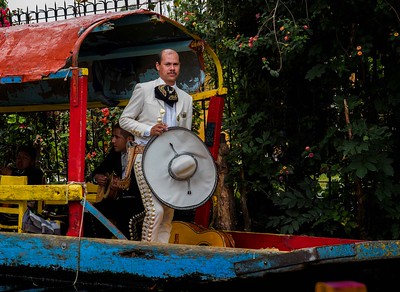
You can also be interested in "The Mexican sombrero is an experience everybody should try".
What is a charro in Mexico?
In Mexico, “charro” is a horse rider or cowboy. They used to work in haciendas or ranches. In the 20th. century, their clothing style got popular. Tightly-fitting and ornamented pants, the embroidered belt, the short jacket or just a “sarape”, wide bow tie, boots, and the popular wide brim “sombrero”.
Depending on which hacienda the rider came from, suits varied in colors, shapes, and the material used to tailor them. So you could have humble and very expensive suits.
Currently, charros exist in Mexico but they don’t use this iconic clothing on a daily basis. This specific suit still can be seen in exhibitions and in “Charrería” events.
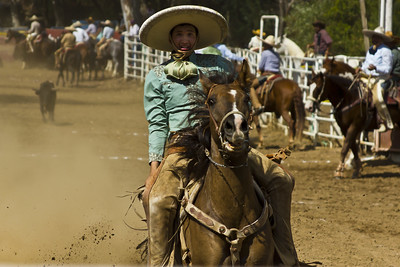
What is Charrería in Mexico?
“Charrería” is a Mexican sport that mixes equestrian activities with livestock traditions used in the haciendas of the old Mexican times.
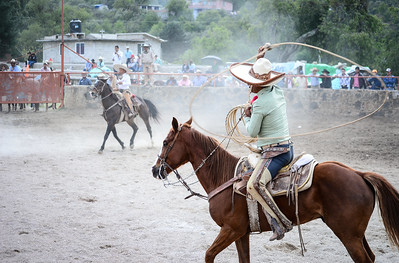
What is the difference between a charro and a mariachi?
In Mexico, a “charro” is a horse rider, a cowboy, or someone who works with livestock in a ranch or hacienda. A “charro” can also be a person involved in “Charrería” (Mexican sport). While a mariachi is a Mexican musician who plays and sings in the traditional ensemble called mariachi too.
The differences in their suits come basically from the purpose they use them. “Charros” need lighter suits to execute the physical challenges the “Charrería” (sport) demands. While mariachis look for more flashy suits for their shows.
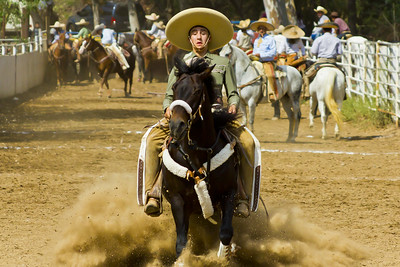
How much does a mariachi suit cost?
The “charro” style suit involves three pieces, the pants, the jacket, and the vest. Really cheap “charro” suits can cost around $90 (USD). A tailored one can start around $300 (USD). Differences in price are based on the quality of the fabric and the embroidery design. Humbler suit’s versions avoid the embroidery. The more ornaments you add, the more expensive the suit will be.
Don’t forget that the budget should include extra money for a shirt, the “sombrero”, a tie, a belt, the boots, and a “sarape” (optional).
There are very expensive “charro” suits. They can reach $17,000 (USD). Of course, they are made of elegant and high-quality fabrics, complex and handmade embroidery, additions like gold or silver buttons, and ornaments.
And don’t be confused. Here we talk about a real “charro” suit, not a costume. There are really cheap “charro” costumes, you can shop online for $30 USD and up.
How much does the mariachi outfit weigh?
A mariachi outfit can weigh up to 5 or 6 kilos. Remember that it is a work tool, so the preferred fabrics to make the suits are thick, for them to last longer. Besides, ornaments and buttons are made from metals, commonly alpaca (nickel silver). But the ones that use silver can go up to 10 kilos.
How long does it take to make a mariachi outfit?
Making a complete mariachi suit can take up to five days. Especially, if it involves designs from scratch and handmade embroidery.
On what occasions do mariachis play?
In Mexico, mariachis play in occasions like engagements, weddings, birthdays, baptisms, serenatas, religious and other holidays, and funerals. After all, their repertoire is vast and it includes all kinds of emotional songs (happy, angry, sad, slow, fast, etc. songs).
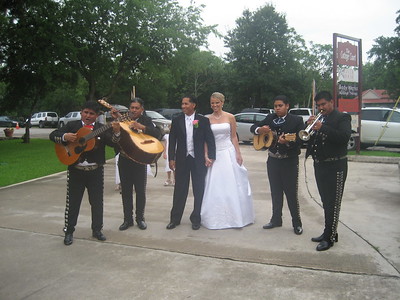
Where can I find mariachis in Mexico?
There are different choices. You can find mariachis in tourist spots like public plazas or downtown. Different Mexican restaurants and bars include a mariachi, as a part of their amenities. Public events during national or religious celebrations can be an opportunity to listen to mariachi. If you go to a birthday, wedding or even to a funeral, there could be a mariachi.
The different states of Mexico usually have a specific place to find mariachis, you should ask the locals. For instance, in the capital, Mexico City, there’s “Plaza Garibaldi” located in the historic downtown. It’s known as “the home of mariachi music”. Guadalajara has “Plaza de los Mariachis”, and so on.

How much does a mariachi cost in Mexico?
Per every song you request to the mariachi, the price can go from $5 to $7 (USD). Usually is how mariachi charges you when the group is in a public place or passing by a restaurant, plaza, street, or bar.
Per hour or per serenata, a mariachi can cost from $97, to $145 (USD) and more.
The price depends on different factors. If the mariachi has to move to a specific address (serenata) or if they play on the place you found it. The number of songs. The number of mariachis (musicians) in the ensemble.
Usually, an hour of serenata means around 45 minutes of music. Based on the length of the songs, it can mean from 8 to 10 songs. A five-member mariachi can be enough for a good mariachi sound. If you are interested in having a specific instrument like trumpet, harp, or violin, you should check it. Not all groups use the same combination of instruments. You can always negotiate to get more songs, time, etc.
If you are lucky and find a mariachi playing in a public event, the experience can be zero cost for you. Or you can only give a tip to the musical group if you like it.
Always be sure about the cost. To directly assume that mariachi, like whatever other product or service, is for free can be an expensive mistake. If they get close to you for singing, if you feel like requesting them a specific song, ask first and very clearly the price and conditions.
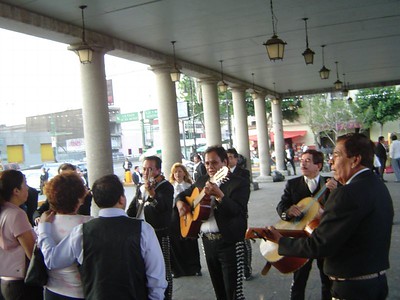
How much do you tip mariachis?
Some people recommend considering how many members the mariachi has to give the tip. Meaning, an amount that once divided, still can be something for every mariachi’s member. But frequently, they are six or more musicians. And honestly, you also have to consider your own budget. Especially in public events and restaurants, we saw people tipping from a couple of American dollars, 5 USD, 10 USD, 15 USD, and more (2020 reference).
There’s no standard amount to tip mariachi in Mexico. And the tip is mostly voluntary! If you don´t like the mariachi, you don’t have to tip.
Just be aware that some restaurants and bars include the mariachi for free (tip is optional). But some mariachis get into those places expecting a fee per every song they sing to you. Some places also establish a minimum amount for the tip. Always check this first. You have totally the right to know the conditions to get this entertainment. If you are ok with the required tip, go ahead. But if it looks not good for you, step back before you get involved in an uncomfortable situation.

What topics does mariachi sing about?
Mariachi sings about all types of topics: love, birth, death, age, honor, national pride, life challenges, betrayal, breakup, jealousy, machismo, women, men, Politics, revolutionary heroes, freedom, poorness, richness, alcoholism, courage, hard-work, animals, country and city life. The mariachi explores all human emotions.
Why do mariachis shout in their songs?
“Gritos” or shouts in the Mexican musical context are frequently part of the way Mexicans celebrate. Mariachis shout in their songs to express pride, joy, or excitement.
Why do mariachis say “Viva Mexico”?
“Viva Mexico” means “long live Mexico”. Mariachis say the phrase to express they are proud of their country, identity, music, etc.
How does a mariachi sound?
Our opinion is, a mariachi sounds alive, powerful, loud, energetic, and emotional. Check by yourself. Here we have a small sample for you to taste it “Long live the amazing Mexican mariachi!”.
Is all Mexican music mariachi?
Of course not all Mexican music is mariachi. That is another mistaken idea people get basically, from the movies. Exactly like to think that all Mexicans wear the wide brim “sombrero” on a daily basis.
The Regional Mexican Music genre is really wide it includes Ranchero (mariachi), Norteño, Jarocho, Banda, Corrido, Grupero, Duranguense, etc. Besides, you can find Pop, Rock, Nortec, Cumbia, etc.
Is ranchera the same as mariachi music?
No, ranchera is not the same as mariachi music. Ranchera music is a genre of traditional Mexican music. The word refers to music that originated in the ranches. Mariachi is a Mexican musical ensemble, not a musical genre. Due to the origin of both, the musical ranchero genre and the ensemble, they are very linked. Ranchero songs have been performed by mariachi for decades. But “rancheras” can be performed in all kinds of Mexican regional music styles. Just like mariachi can perform other genres, modern ones included. You can see some examples clicking here: “Long live the amazing Mexican mariachi!”.
What is the most requested mariachi song?
“Las Mañanitas” is so far the most requested mariachi song. It’s the Mexican equivalent of the American “Happy birthday”. This has total sense if you consider birthdays are a common occasion to celebrate and to have serenata. This song is the way to start it and to surprise the birthday girl or boy.
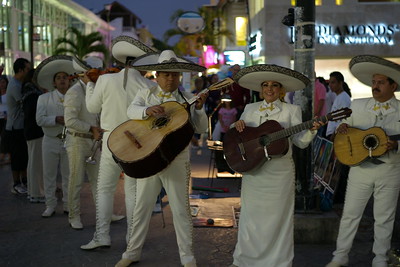
What songs should I request a mariachi?
There are many songs you can request a mariachi, but here you have our proposal:
- Mexico Lindo y Querido.
- El Son de la Negra.
- La Bikina.
- El Rey.
- Cielito Lindo.
- El Aventurero.
- Volver, Volver.
- La Cucaracha.
- 100 años.
- Cucurrucucú Paloma.
Top 3 mariachi songs.
This is absolutely our personal opinion, guys:
- El Aventurero.
It’s fun and it has a great, fast rhythm.
- Cielito Lindo.
The Mexican "war" song to support Mexicans in international competitions, like football ones. And it’s actually a positive and romantic song dedicated to a lady.
- La Bikina.
Mariachi sounds different, slower, less thunderous, more melodic.
What’s the difference between mariachi and banda music?
There’s a big difference between mariachi and banda music: instrumentation. Banda musical groups mainly use brass, winds, and percussions. A louder combination of instruments than the mariachi one. Mariachi is based on stringed instruments with the addition of a wind instrument, the trumpet. The different instrumentation used by banda and mariachi gives as a result a really different sound. Also, the vocals style is different. There’s no way to confuse them.
What is the most famous mariachi?
The most famous mariachi is the “Mariachi Vargas de Tecalitlán”. It was founded in 1898 by Gaspar Vargas in Tecalitlán, Jalisco. It’s the oldest Mexican mariachi ensemble and its popularity has reached the international level. They are still playing. The group has been a family business for many generations already.
Other famous mariachis:
- “Mariachi México de Pepe Villa”, founded in 1953 and still playing.
- “Mariachi Internacional de Guadalajara”, founded in 1989.
What is the most famous mariachi singer?
To point out only a name as the most famous mariachi singer is hard. When you ask Mexicans, they have a long list in mind. And they have at least two categories, old and contemporary most famous singers.
Old famous mariachi singers: Pedro Infante, Jorge Negrete, José Alfredo Jiménez (also composer).
Contemporary famous mariachi singers: Vicente Fernández, Alejandro Fernández, Pepe Aguilar, Pedro Fernández.
All of them have become internationally famous, due to a large amount of sold albums and sold-out arenas.

Who is the most famous female mariachi singer?
The most famous female mariachi singer in Mexico is Aída Cuevas.
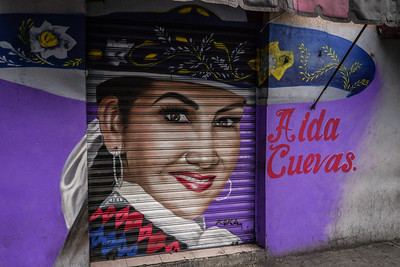
You can also be interested in "The Mexican sombrero is an experience everybody should try". Or "Long live the amazing Mexican mariachi!".
Join PackandGo.info !
| Follow PackAndGo.info at: | |
| YouTube | @packandgo. |
| @packandgo.info | |
| X | @packandgoinfo |
| Bluesky | @packandgo.bsky.social |
| @packandgo.info | |
| TikTok | @packandgo.info |
- Details
- Written by: Martin Pramatarov
- Hits: 5395
When I visited Mexico for the first time, I had a very exciting, maybe childish, objective. I really wanted to wear a real Mexican sombrero!
I have seen it everywhere! It’s a fun accessory that can appear in bars or costume parties. If you like sports and Mexicans are participating, it’s very easy to spot their supporters. No matter the size of the stadium or venue, Mexican sombreros can’t be unnoticed.
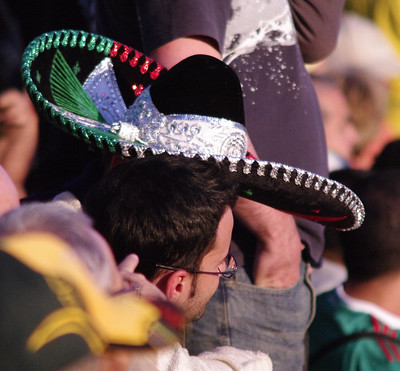
Once in Mexico, I could see different Mexican sombrero styles, from cheap ones to some really refined and expensive ones with handmade embroidery. I also discovered interesting facts about this popular accessory that I will share with you!
Share your travel experiences with us! Packandgo.info
| Follow PackAndGo.info at: | |
| YouTube | @packandgo. |
| @packandgo.info | |
| X | @packandgoinfo |
| Bluesky | @packandgo.bsky.social |
| @packandgo.info | |
| TikTok | @packandgo.info |
What is the origin of the hat?
This is very interesting because the hat seems not to have a specific origin. It was not a brilliant idea of someone, but a brilliant idea of different people around the world. Hat’s creation was motivated by a simple and clear reason: hot weather. People living in really hot places felt the need to protect their heads and faces to avoid insolation and sunburns.
It’s clear hats were created a long time ago. Some early hats were traced in Ancient Egypt, the Roman Empire, and the Middle Ages. And after time, it became a fashion and a popular accessory worldwide.
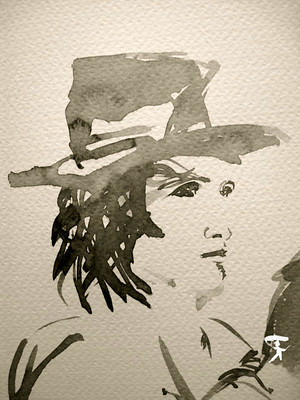
Is sombrero Mexican?
Yes, the sombrero is Mexican, at least what we know now as the Mexican sombrero. But historians mention there’s a direct Spanish influence on it. First of all, the origin of the name sombrero it’s absolutely Spanish. It comes from the Spanish word sombra (shade), and it started being used in the 15th century. It’s a fact, Spanish was not the native language in Mexico.
Talking about the hat, it’s documented that there was a wide-brim hat in Andalucía, Navarra, and Salamanca. In the first two regions, it seemed to be an accessory for wealthy landowners. And in Salamanca, it was part of the horse rider outfit. When Spanish conquerors arrived in Mexico, for sure the use of the sombrero also did.
An own Mexican sombrero was created in Central Mexico and used by Mestizo cowboys. And then, it spread around the rest of the country.
The exact origin of the Mexican hat has been the subject of debate. Some recognize it as a Mexican creation. Others attribute their origin directly to Spain, even though the differences between the mentioned Spanish hats and the Mexican hat are visible.
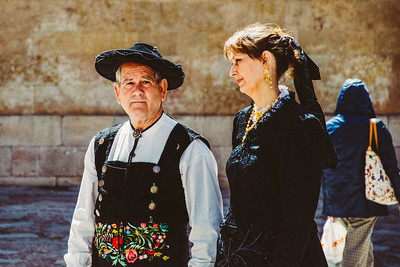
What is a Mexican sombrero?
Mexican sombrero is sombrero de “charro” - a big, sometimes even massive, circular hat. This sombrero type has become a Mexican symbol, part of the folklore and culture of the country.
Historically and nowadays, Mexicans have worn different types of hats. Mexico is a big country. The hat’s design (style) varies based on the part of the country where you are. Materials, short or high crowns, narrow or wider brims are different.
But when people say Mexican sombrero, usually they mean the traditional and popular sombrero de “charro”. This is exactly the kind of hat that Mexican cowboys, horse riders, and mariachis wear.
Charro in Mexico refers to horse riders or cowboys who traditionally worked with livestock in the “haciendas” or ranches. Their outfit became popular and easy to spot. Tight-fit pants, belt, short jacket or only “sarape”, vest, wide bow tie, boots, and sombrero (hat). Ornaments, quality materials, and colors on “charros” suits were different based on the “hacienda” they came from.
By the way, now I know that when the hat is massive, the reason is that you didn’t get the proper size. The size of the ideal sombrero for you is defined by the head measures and the height of the person who will wear it.
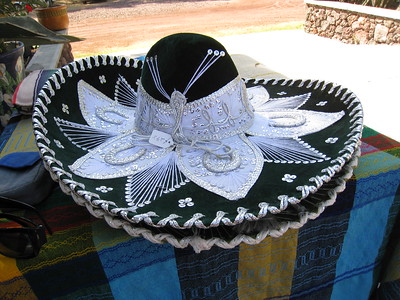
How is a Mexican sombrero (de charro)?
The Mexican sombrero or “charro” hat varies based on the geographical location you are in. In the North of Mexico, where you find some of the driest areas, sombrero’s materials are lighter, cooler, and the brim is wider. This changes if you are in wooded areas, and in the South, where humidity is higher.
Therefore, a sombrero can be made of palm, wheat straw, wool, leather, suede, or rabbit hair. Materials must be balanced to make the sombrero a solid piece that can stand on the user’s head. It’s a wide-brimmed hat, raised at the back. Its crown can be flat, but usually, it’s shaped with several creases, called “pedradas” in Spanish (frequently four) to provide resistance to the sombrero in case of an impact (mostly falls).
Ornaments are an important detail and usually vary based on personal taste. The most refined sombreros have embroidered designs. Flower figures are usually the most preferred design. Sombreros can have “toquillas”, ornaments placed around the cylinder that shapes the crown, mostly in the lower part. They can be made of chiffon, ribbon, etc. “Ribetes” are also included, narrow strips or trims (ribbon, lace, etc.) to reinforce and adorn the edge of the sombrero. They can be embroidered or openwork trims.
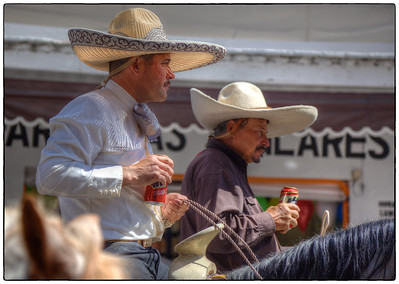
Why should I wear a Mexican sombrero?
You definitely should wear a Mexican sombrero to have fun! That was absolutely my case. It feels rare at the beginning, especially if you are not a regular hat user like me. But it totally gives an accent, a unique touch to your image.
Besides, you should wear a Mexican sombrero because of its benefits. Its wide brim protects you from the sun, wind, dust, and rain. Whether you walk or you ride, you can be protected while keeping your hands free! That’s better than holding an umbrella. It means protection for your head, a sort of helmet, in case of impact (stones, tree branches, or falls).
And if you have seen old Mexican movies, you know a sombrero can be very useful for different purposes.
- To stir up the fire of a bonfire.
- To collect water for drinking yourself or sharing it with your horse.
- To play and dodge a bull pretending you are a bullfighter.
- To use it as a shield in case of a fight or a knife attack. It will be a one-shot resource, but still, it can save you.
- To protect (cover) your identity.
- To kiss your loved one, avoiding prying eyes with the wide brim.
Charros seemed to be very creative in taking full advantage of their sombrero!
In any case, the Mexican sombrero is an experience everybody should try! Don’t miss it on your next trip to Mexico.
Share your pics and experience with us, packandgo.info.
| Follow PackAndGo.info at: | |
| YouTube | @packandgo. |
| @packandgo.info | |
| X | @packandgoinfo |
| Bluesky | @packandgo.bsky.social |
| @packandgo.info | |
| TikTok | @packandgo.info |
- Details
- Written by: Gianna Esquivel
- Hits: 2266
The music is an amazing human expression! It is a great company, inspiration, relaxation, catharsis, and a great way of traveling. Through songs, their lyrics, rhythm, instruments they are played with, we can know a bit more about people around the world. Their roots, what makes them sad, happy, angry, worried, etc. Music makes us sing, jump and shake the body but it also encodes a lot of cultural elements that are worthy to know.
Let’s explore together the case of the popular Mexican mariachi!
| Follow PackAndGo.info at: | |
| YouTube | @packandgo. |
| @packandgo.info | |
| X | @packandgoinfo |
| Bluesky | @packandgo.bsky.social |
| @packandgo.info | |
| TikTok | @packandgo.info |
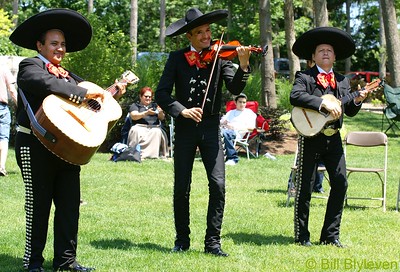
What’s mariachi?
The mariachi is the iconic musical ensemble of Mexico that incorporates mostly stringed, but also wind instruments to play and vocals. Mariachi is an indigenous Mexican word attributed to the already extinct Coca language. Coca people were an old indigenous group that settled in the region of the current states of Nayarit, Jalisco, and Colima.
Traditionally, these ensembles feature at least three musicians (guitar, guitarrón, and vihuela performers) dressed in “charro” suits. There’s no limit up to integrating a mariachi. Currently, there are musical groups of more than ten members. The mariachi is an important element of the Mexican tradition and identity. The word mariachi is also used to point out every member of the musical ensemble. The performers are mariachis and the group they integrate is a mariachi.
These kinds of ensembles boosted the popularity of the musical genre called “ranchero”. It’s an iconic Mexican genre considered in a wider category called “regional Mexican music”.
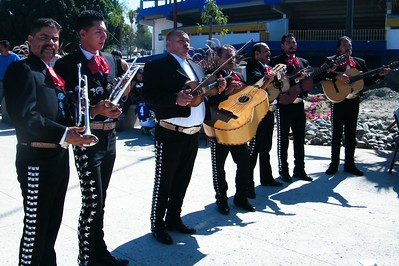
What’s the origin of mariachi? Is mariachi Mexican?
Yes, the mariachi is Mexican! It was born as a result of a mixture of different influences, the indigenous Mexican, the African, and the European ones. Africans arrived in Mexico together with the Europeans (16th century).
By the time the Spanish arrived in Mexico (1519), the Mexican indigenous had already developed their own musical instruments and traditions. European musicians brought to the new land their own music, just like the African slaves. With time, Mexican indigenous got interested in the foreign instruments and rhythms so they mastered them and incorporate them into their own music.
The mariachi grew up in a big Mexican region that included the current states of Sinaloa, Durango, Colima, Michoacán, Aguascalientes, Guanajuato, Zacatecas, Jalisco, Nayarit and Guerrero. Commonly, Jalisco is mentioned as the place of its origin. Truth is, there’s no certainty about the exact mariachi birthplace. Its presence has been traced all around this region.
The fusion of the indigenous teponaztlis, reed flutes, caracolas, and other native instruments, with the foreign guitars and violins, originated the earliest version of mariachi (17th. century).
A documented reference shows that mariachi is mentioned by the priest Cosme Santa Anna in a letter (1852). The musical ensemble is described as an element of the rural parties. Frequently, people were dancing on a wooden platform called “tarima” while mariachi was playing “jarabes” and “sones”. These last are common musical genres played by mariachi.
At this stage, the performers (mariachis) didn’t wear the current “charro” style clothing. They were mostly wearing peasant garb and palm hats, regional clothing related to rural activities.
The Mexican Revolution was a hard war decade for Mexicans (1910-1920). And exactly at that time, the mariachi got really popular and became a pride symbol, present in all types of events of poor, middle, and high classes.
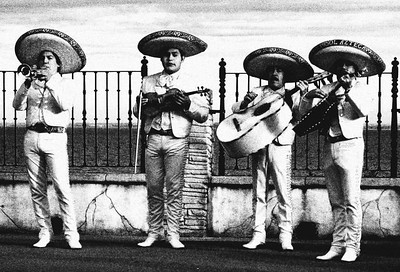
At the beginning of the 20th. century, the “charro” suit replaced the peasant garb that mariachi performers used to wear. The “charro” suit was the kind of clothing used by cowboys and horse riders. Depending on which hacienda the rider came from, suits varied in colors, shapes, and the material used to tailor them. Richer men wore suits made of wool, suede, trimmed with silver, etc. There were also humbler versions of suits. The palm hat also was changed for a wide brim hat. The first ensemble that adopted this suit as a uniform was “The Cirilo Marmolejo’s Mariachi”. And in 1930, trumpets were included by the same musical group to innovate the sound.
The radio and television positioned mariachi nationally. But the following years marked the beginning of one of the best moments of the Mexican film industry. And mariachis were a constant and successful element in many movies (“rancheras”). The Golden Age of Mexican cinema (1936-1956) totally boosted mariachi to the international level as an icon of the Mexican culture.
What instruments are used in a mariachi?
Instruments and the amount of them can vary between the different groups, mostly based on regional tendencies. But in general, the instruments that are used in a mariachi are the following.
- Mexican vihuela.
Mexican vihuela is a small, guitar-like instrument. It basically has five strings and a convex (vaulted) back. This instrument is tuned an octave higher than a guitar is. Therefore, vihuela gets a higher pitch or tenor sound. This instrument is one of the bases of the mariachi’s sound. It complements the low tuning of the guitar.
There’s a Spanish vihuela but don’t be confused, they are not the same instrument. Their different features give as a result different possibilities and sounds.
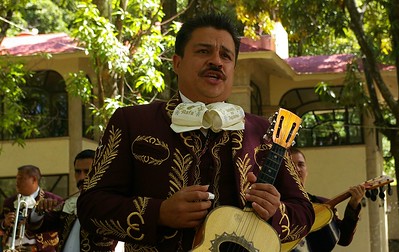
- Mexican guitarrón.
Guitarrón is a large, plucked instrument with six strings, a deep body, and acoustic bass. Another key instrument for a mariachi. Its size provides volume enough not to depend on electric amplification. Of course, the need for amplification will be finally defined by the venue’s size. Its higher three strings are usually made of nylon, while the lower three are made of metal. The Mexican guitarrón produces a powerful sound every time you pull a string. Its convex back and the hollow and large body improve lower frequencies. As a result, a rich bass sound is produced and it becomes the backbone sound line of mariachi, together with the Mexican vihuela and the guitar.
The Mexican guitarrón is a vital and colorful instrument for mariachi. Both, its size and warm sound can’t be unnoticed.
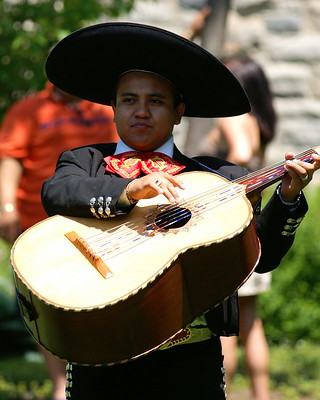
- Guitar.
Originally, mariachis included the Mexican “guitarra de golpe”. It was a guitar especially developed by Mexican mariachis-musicians. But with time, it has been replaced in many groups (not all) by the classical Spanish guitar.
Basically, guitarra de golpe has 5 nylon strings, a slimmer neck, and a design for the instrument not to buzz when the rhythm is played.
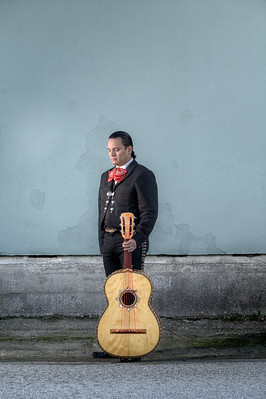
- Violin.
The violin adds to the mariachi a powerful tone and strong vibrato; a clear anchor for the mariachi’s sound. The violin or violins are used to get “grace notes” (ornaments), pizzicato, and interesting countermelodies with the trumpets. This means violins can produce rhythmic and melodic contrasts with the main melody or with the trumpets’ part.
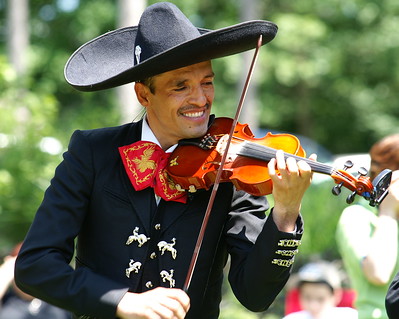
- Trumpet.
The trumpet is the latest and a “flashy” addition to mariachi but now it’s considered an essential. The instrument adds a thick, wide sound, and what is called in music, a “crisp sound”. Meaning, a bright sound that can even overtake the melody. Trumpet solos in mariachi are not rare and people like them. The high-pitched and bracing trumpet’s tone is a must for the classic fanfare that points out loud the presence of mariachi. It’s also an accent to emphasize the “celebration” mood.
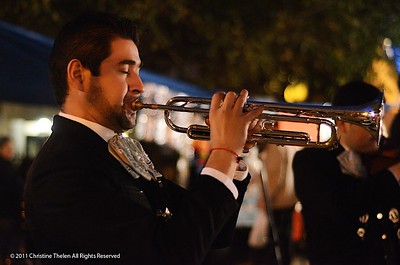
- Vocals.
Singers are another important element. The vast repertoire of mariachi also includes instrumental music and instrumental versions of popular songs. But vocals are traditionally used. The difference with other musical groups is that in mariachi is not a must to have a lead singer. There can be more than a single singer and in fact, all the members of the ensemble frequently sing harmonically all together or specific verses of the songs.
The lead singer or singers are chosen based on their specific voice’s qualities and the needs songs (genres) demand.
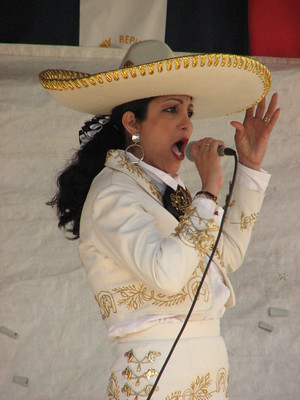
- Harp.
The most popular harp used by mariachi is the Jalisco harp. But it’s a preference, not a rule. It can have up to thirty-six strings. The shorter strings (length) provide a higher pitch (soprano, tenor). While the longer strings provide a lower (bass) pitch. Sometimes the harp is skipped because it’s hard to tune and transport.
The harp can be used by the mariachi with different objectives. It can play the bass line together with the guitarrón. It can play a melody line, chords, and arpeggios.

In some Mexican regions, mariachis can include the flute and even an accordion.
You can get more interesting information about mariachi in "Everything you need to know about the Mexican mariachi!". And you also can be interested in "The Mexican sombrero is an experience everybody should try!".
Is mariachi still popular?
Yes, mariachi still is really popular! This ancient Mexican tradition is absolutely alive. It’s not something you only can appreciate in a museum as it happens with other traditions. It’s in the Mexican streets, in all types of celebrations and in the world!

In 2011, the United Nations Educational, Scientific and Cultural Organization (UNESCO) registered mariachi as an intangible cultural heritage.
The Grammy Award includes a category to honor the best “Regional Mexican Music”. The award has been gotten different times by contemporary singers of “música ranchera” performed with mariachi.
We have said enough. But honestly, music is to be listened to! That’s why we have prepared for you, a short sample of mariachi songs for you to taste. Through this sample, you can also see how the mariachi has evolved to modern times and some of the variants it offers.
- Song: “Viejos Amigos”.
From the Mexican movie: “El Enamorado” (released, 1952).
In the 20th. century, radio and television were important for this music to be appreciated all around Mexico. But cinema was key for mariachi to become popular, nationally and internationally.
- Song: “Coplas”.
From the Mexican movie: “Dos tipos de cuidado” (released, 1953).
This is still a very popular “ranchera” movie. The protagonists, Pedro Infante and Jorge Negrete were considered two of the biggest stars (singers and actors) of the period called the “Golden Age of Mexican cinema”.
- Song: “El Son de la Negra” (released 1998).
Performed by Mariachi Vargas de Tecalitlán.
This mariachi was founded by members of the Vargas family, on September 15, 1898. In 1937 they began recording their first albums. Now, new generations of the family keep this mariachi’s reputation. It’s considered one of the best Mexican mariachis.
- Song: “La Bikina” (released 2000).
Performed by Luis Miguel, a Mexican singer (born in Puerto Rico) who has sung in different genres, including mariachi. He’s considered one of the best-selling singers Mexico has had.
- Song: Pumped up Kicks (mariachi version, 2012).
Performed by Foster the People and mariachi “Real de Guanajuato”.
Vive Latino is an annual music festival held in Mexico City. During its 2012 edition, “Foster the People”, an American indie pop band formed in Los Angeles, California, surprised the Mexican audience with a mariachi version of the popular song “Pumped up Kicks”.
- Saint Motel.
This American indie pop band from Los Angeles has released mariachi versions of many of its most popular songs. They seemed to start this idea in 2017 with titles like “Ace In The Hole” and “My Type”. Through time, the band has repeated the formula due to its success. In these versions (instrumental), the mariachi is the absolute protagonist.
- “Preach” (released 2020).
Performed by mariachi “Los Toros”.
- “It’s all Happening” (released 2021).
Performed by mariachi “Los Toros”.
- Song: “My Type” (released 2017).
- Song: “Ace In The Hole” (released 2017).
- Song: “Te Olvidé” (released 2020).
Performed by Alejandro Fernández, a Mexican singer who has sold over 20 million records around the world.
Is it worth to listen mariachi?
To listen to a mariachi is one of the things everybody will recommend if you visit Mexico. And we can say that it’s totally worth a try! You can listen to this music in its most traditional version or mixed with contemporary rhythms. Of course, you can like it or not. But we can say, it won’t be a boring experience. When a mariachi starts playing, people around sing, dance, and have fun!
We had very cool experiences in different Mexican restaurants that have mariachi as an amenity, and in the Plaza Garibaldi too. This last is known as Mexico City’s home of mariachi music. Honoring those great memories, today's toast is, long live the amazing Mexican mariachi!
You can get more interesting information about mariachi in "Everything you need to know about the Mexican mariachi!". And you also can be interested in "The Mexican sombrero is an experience everybody should try!".
Join PackandGo.info !
| Follow PackAndGo.info at: | |
| YouTube | @packandgo. |
| @packandgo.info | |
| X | @packandgoinfo |
| Bluesky | @packandgo.bsky.social |
| @packandgo.info | |
| TikTok | @packandgo.info |
